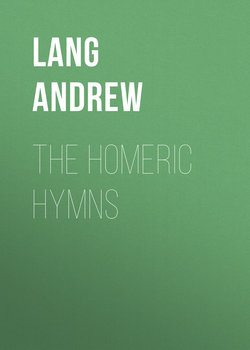Читать книгу The Homeric Hymns - Lang Andrew, May Kendall - Страница 6
THE HYMN TO DEMETER
ОглавлениеThe beautiful Hymn to Demeter, an example of Greek religious faith in its most pensive and most romantic aspects, was found in the last century (1780), in Moscow. Inter pullos et porcos latitabat: the song of the rural deity had found its way into the haunts of the humble creatures whom she protected. A discovery even more fortunate, in 1857, led Sir Charles Newton to a little sacellum, or family chapel, near Cnidos. On a platform of rock, beneath a cliff, and looking to the Mediterranean, were the ruins of the ancient shrine: the votive offerings; the lamps long without oil or flame; the Curses, or Diræ, inscribed on thin sheets of lead, and directed against thieves or rivals. The head of the statue, itself already known, was also discovered. Votive offerings, cheap curses, objects of folk-lore rite and of sympathetic magic, – these are connected with the popular, the peasant aspect of the religion of Demeter. She it is to whom pigs are sacrificed: who makes the fields fertile with scattered fragments of their flesh; and her rustic effigy, at Theocritus’s feast of the harvest home, stands smiling, with corn and poppies in her hands.
But the Cnidian shrine had once another treasure, the beautiful melancholy statue of the seated Demeter of the uplifted eyes; the mourning mother: the weary seeker for the lost maiden: her child Persephone. Far from the ruins above the sea, beneath the scorched seaward wall of rock: far from the aromatic fragrance of the rock-nourished flowers, from the bees, and the playful lizards, Demeter now occupies her place in the great halls of the British Museum. Like the Hymn, this melancholy and tender work of art is imperfect, but the sentiment is thereby rather increased than impaired. The ancients buried things broken with the dead, that the shadows of tool, or weapon, or vase might be set free, to serve the shadows of their masters in the land of the souls. Broken as they, too, are, the Hymn and the statue are “free among the dead,” and eloquent of the higher religion that, in Greece, attached itself to the lost Maiden and the sorrowing Mother. Demeter, in religion, was more than a fertiliser of the fields: Korê, the Maiden, was more than the buried pig, or the seed sown to await its resurrection; or the harvest idol, fashioned of corn-stalks: more even than a symbol of the winter sleep and vernal awakening of the year and the life of nature. She became the “dread Persephone” of the Odyssey,
“A Queen over death and the dead.”
In her winter retreat below the earth she was the bride of the Lord of Many Guests, and the ruler “of the souls of men outworn.” In this office Odysseus in Homer knows her, though neither Iliad nor Odyssey recognises Korê as the maiden Spring, the daughter and companion of Demeter as Goddess of Grain. Christianity, even, did not quite dethrone Persephone. She lives in two forms: first, as the harvest effigy made of corn-stalks bound together, the last gleanings; secondly, as “the Fairy Queen Proserpina,” who carried Thomas the Rhymer from beneath the Eildon Tree to that land which lies beyond the stream of slain men’s blood.
“For a’ the bluid that’s shed on earth
Flows through the streams of that countrie.”
Thus tenacious of life has been the myth of Mother and Maiden, a natural flower of the human heart, found, unborrowed, by the Spaniards in the maize-fields of Peru. Clearly the myth is a thing composed of many elements, glad and sad as the waving fields of yellow grain, or as the Chthonian darkness under earth where the seed awaits new life in the new year. The creed is practical as the folk-lore of sympathetic magic, which half expects to bring good harvest luck by various mummeries; and the creed is mystical as the hidden things and words unknown which assured Pindar and Sophocles of secure felicity in this and in the future life.
The creed is beautiful as the exquisite profile of the corn-tressed head of Persephone on Syracusan coins: and it is grotesque as the custom which bade the pilgrims to Eleusis bathe in the sea, each with the pig which he was about to sacrifice. The highest religious hopes, the meanest magical mummeries are blended in this religion. That one element is earlier than the other we cannot say with much certainty. The ritual aspect, as concerned with the happy future of the soul, does not appear in Iliad or Odyssey, where the Mysteries are not named. But the silence of Homer is never a safe argument in favour of his ignorance, any more than the absence of allusion to tobacco in Shakspeare is a proof that tobacco was, in his age, unknown.
